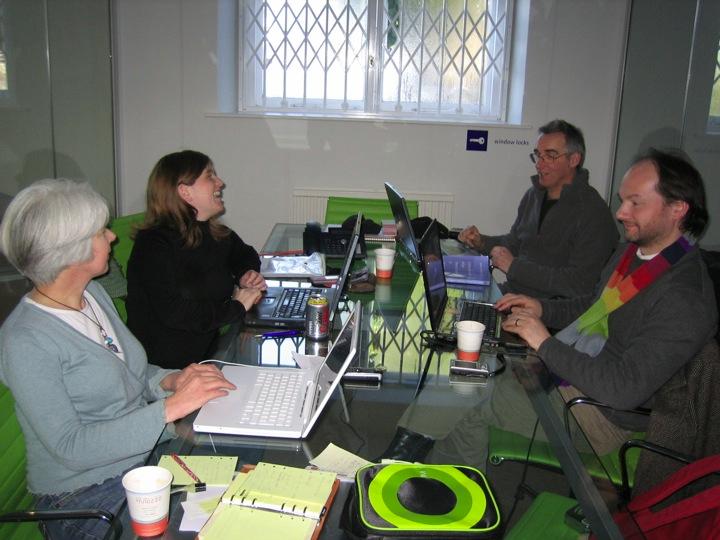Nobody holding a Jelly in your area and getting a little envious when you hear how fantastic it is?
Why not start your own Jelly? That’s how all the others have come about – someone finding out about the concept and being sufficiently fired up to get it going where they live!
This post is designed to help you get Jelly going as quickly and painlessly as possible.
What is Jelly?
Jelly is a casual coworking event, where freelancers, home workers, and people running small businesses meet up in order to get out of their normal space, meet some new people and work together in a social environment. Jelly is a mixture of work, chat, comparing of ideas, passing on tips and help, and maybe sometimes collaboration on the birth of a new project.
(Jelly differs from networking in that the aim is not to find new clients, pitch your business or to sell. Try that at Jelly and you will not be popular).

Getting started
Obviously, the best way to get the feel for the relaxed vibe of Jelly is to attend one! It’s also an ideal opportunity to grab some time with the organizer when they’ve got their Jelly hat on rather than doing their regular day job. Many of your questions (‘What actually happens at a Jelly?’, ‘What is my role as an organizer?’ etc) will be answered just by being there.
But this assumes there is a Jelly within a reasonable traveling distance. If not, don’t worry, this guide will set you on the path to successful Jelly.
Where to hold Jelly
In the States, Jelly began in someone’s apartment and there’s no reason you can’t have Jelly in your home. Except one of your reasons to start Jelly may be to get away from home! So if you prefer to find another venue this is what you need:
- A central, easy to find a location that won’t charge for room rental
- Free wi-fi
- Enough power points for everyone or your laptop batteries will run out before Jelly is over
- A room with table space, either several small tables or a large one everyone can sit around, and chairs at a comfortable height
- A constant supply of drinks and possibly food, although Jellyers can always bring their own snacks and sandwiches or pop out for them
You can consider coffee shops (bear in mind they can be noisy and may get very busy at peak times), established coworking spaces, serviced offices, business centers, or community halls.
Ascertain as best you can that the venue satisfies your requirements (ie visit the coffee shop in question to see how many power points there are and whether wi-fi is provided free to customers). When you’re satisfied it’s a good prospect, contact the owner/manager to introduce the idea of Jelly.
How to sell Jelly to the venue
As we’ve seen, Jelly is a totally free event, so you’ll need some good arguments to convince venues to accommodate you free of charge. Fortunately, we have a number of tried and tested options up our sleeves!
A coffee shop will benefit from having a captive audience for the day who need to buy food and drink. It makes the place look busy and popular and Jellyers are very likely to return if they like it, either socially or for a business meeting, thus helping with word-of-mouth marketing.
A coworking space will be interested in getting its target market of freelancers and home workers through the door so they can see the attractions of renting a desk or office space there in the future.

The venue host: Gavin Eddy of The Old Church School in Frome, Somerset, on why he is delighted to host regular Jelly in his coworking space:
“I run a workspace company that specializes in providing innovative space to small businesses, so for us Jelly has a number of benefits –
1. It gets home workers through our doors who might then be interested in using our workspace and meeting rooms on a more regular basis
2. It provides a buzz to the building on days when we might not otherwise be at capacity
3. It is a cost effective method of PR and marketing to a group of people that are otherwise below the radar
4. It enables us to engage with potential users of our workspace about how to improve our offer
5. It raises our profile in the local community and enables us to give something back which is aligned to our core business
6. And finally because
Jelly is fun and work should be fun….”

People tend to either catch on immediately and be desperate to take part, or they just don’t get it at all. Let’s hope you are talking to the enlightened.
Publicizing Jelly
Once you’ve got your venue arranged and date agreed:
- Start your new location’s page on the Jelly Wiki by signing up for an account and then explaining briefly what Jelly is, who it is for, and where and when you are hoping to start. This gives you a basic free webpage you can direct people towards when you start to publicize
- Spread the word among friends, colleagues, clients, suppliers, anyone who might be interested or know people who would be interested. Likely prospects – anyone who works in IT, writers, editors, VAs, coaches, trainers, people whose work is portable and who need some company
- Create an email list of the above people
- Put the word around at groups you already belong to
- Twitter – tweet about your forthcoming Jelly and ask your followers to retweet
- Put the word out on Linkedin and Facebook
- Local media – local papers and radio stations are always on the lookout for content for their publications and shows. Fortunately, the name Jelly is always a good hook to get them interested! Send out a press release a couple of weeks before the Jelly date and follow up with a phone call to check it has been received and answer any questions. Write a concise and catchy press release and it will probably be printed verbatim, like mine for Frome Jelly
- Print out posters with the eyecatching red and yellow Jelly logo and put them up in places where prospective Jellyers will see them – libraries, coffee shops, community notice boards, etc.
Organizing Jelly
Set up your own account at Eventbrite, a brilliantly simple and efficient site where you can create your own event, add copious details including a map, set up a time for tickets to become available, ‘sell’ tickets, list attendees and create a waiting list when all places are taken. You’ll receive emails from Eventbrite pointing to many other useful features and reminding you of key points. All this for absolutely no charge because Jelly tickets are free.
A similar service is offered by Amiando, although I’ve never tried it and haven’t heard any feedback yet.
Check the Jelly Wiki and your Jelly contacts on Twitter to find out if other Jellys are happening on the same day. If so, you might want to contact their organizers and arrange a time for a #jellymoment when all the people attending, plus others who can’t make it, can connect on Twitter. The first time we tried it, Jellys in Frome, Cardiff, and Coalport trended third in the UK for half an hour or so!
Contact the venue a couple of days before the event to confirm the time and other details. Ask a coffee shop to put ‘reserved’ signs on the tables designated for Jelly to avoid moving customers already settled there.
Hosting Jelly
Arrive at the venue with plenty of time to check furniture, wi-fi passwords, etc. Depending on the facilities provided by the venue, a ‘Jelly kit’ could help the day to go smoothly and could include:
- Extra mugs
- A 4 plug socket or two if power points are limited
- A flipchart to write up the day’s wifi password where everyone can easily see it. Jellyers are often (though it’s by no means compulsory!) regular tweeters, so also write up hashtags like #coworking, #Jelly, the venue’s Twitter name, etc for those who will be tweeting. Get Twitter users to write their Twitter names on the flipchart when they arrive so others can tweet about who’s there and find new people to follow
A jelly is a casual event so there’s no expectation people will turn up at the start time and stay till the end. Jelly only needs a light touch, so all you need do is greet arrivals and if necessary introduce yourself and other Jellyers. Jelly then takes on a life of its own and each one is different.
I really like the fact that Jelly has no organizing body and no rules, and that anyone with enough enthusiasm for the idea can run their own. This means that each Jelly develops its own character depending on who runs it and who turns up. It also means it’s up to you to set the tone and decide what you do and don’t want to happen at your Jelly.
I strongly believe in the power of coworking and Jelly to help freelancers and home workers get out of the house, pick up tips, advice, and new ideas, and generally get motivated to run great businesses to support themselves and their families.
So I prefer to keep any kind of pitching or selling firmly out of Jelly. I see that as one of the defining features of Jelly and, after all, there are masses of networking events where you can go to sell.
So it would be helpful to decide what your position is on that question, and any others you feel strongly about, and how you would deal with a situation where your values were being compromised. It will probably never happen, but being prepared will help you feel confident you can deal with any eventuality.
You will find there are times during Jelly when everyone is quietly beavering away with their work and then suddenly a burst of chatter will erupt, as in the photo above of Frome Jelly in January 2010! (From left to right – me, Natalie Andrews, Andy Britnell, and John Scott). In my experience Jelly in coffee shops tends to be more social for obvious reasons.
You might actually have to encourage people to leave once Jelly is over! The venue may need their space back for a certain time so keep an eye on the clock as you want to stay in their good books. The talk as people pack up and leave will be all about what a great day they’ve had and when can they do it again.
Do a quick scout round to make sure you’re leaving the place clean and tidy, tables clear, rubbish in bins, chairs under tables. Return windows, radiators, furniture, etc to how it was when you arrived.
A thank you email the day after never goes amiss.
More Jelly
Now you’ve got your Jelly legs it would be a good idea to find other venues in case your first becomes unavailable for any reason. Spread the love!
Enjoyed this and want to know more? Try –
Coworking for home workers and freelancers








